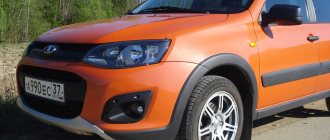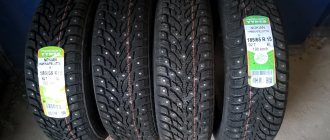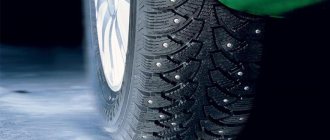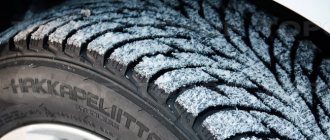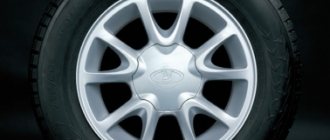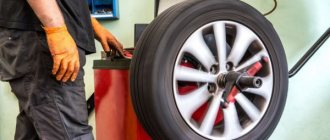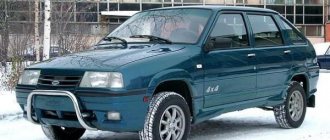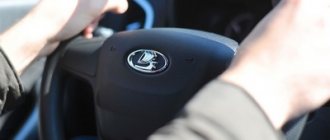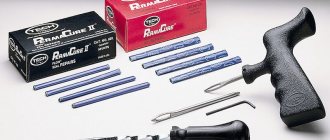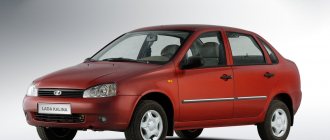Test of winter studded tires 195/65 R15
For the next stud test, Za Rulem experts collected six sets of 15-inch tires from Western and Eastern manufacturers. Some have experience and the latest technologies among their trump cards, while others have the will to win and affordable prices. And each tire has its own pros and cons. This time, one of the most popular dimensions was chosen - 195/65 R15, which suits many small and inexpensive cars. Different markets, different understanding of the product, different design schools. What distinguishes tires from the East and West from each other, what are their strengths and weaknesses, and what should the Russian buyer pay attention to?
East
The latest Bridgestone Blizzak Spike‑02 model is the most expensive in the eastern team, but cheaper than the European giants. Another new product, Hankook Winter i*Pike RS 2, is a tire with an increased number of studs and an updated tread pattern. It replaces the Winter i*Pike RS model. This year it will appear in Russia in 57 sizes - from 155/65R 13 to 255/40 R19. The new Toyo Observe Ice-Freezer replaces the Observe G3‑Ice and will be available this fall in 16 sizes ranging from 14 to 19 inches. The rubber mixture includes silicon dioxide, which provides elasticity in cold weather, and microparticles of walnut shells for additional grip on ice. Another model with Japanese roots, now produced in Russia, is the Firestone Ice Cruiser 7. Previously, this tire had an index of 7000 and belonged to the Bridgestone brand line. The next player from Japan is Nitto Therma Spike, a “relative” of the Toyo brand. These tires take part in our tests for the second time and are characterized as inexpensive, with modest characteristics. The new GT Radial IcePro 3, which replaces the GT Radial Champiro IcePro, was developed in its own research and development center in Hannover. And the GT Radial brand is owned by the growing international company Giti, based in Singapore. The new product is available in 22 sizes - from 175/65 R14 to 225/60 R17. The tires participating in the test are made in China.
West
There are no new products in the Western team, but the players are incredibly strong, since the manufacturers update most of these tires annually. Nokian Hakkapeliitta 9, the most expensive tire on the domestic market, is the only one in the world with two different types of studs. Continental IceContact 2 is also one and only: its “studs” are glued into the tread, and therefore stay in it very firmly. Cheaper tires include Goodyear UltraGrip Ice Arctic, which has repeatedly won prizes in our tests, and Pirelli Ice Zero. The western team is completed by two direct competitors, representatives of the second echelon of the companies Continental and Nokian - the Gislaved Nord*Frost 200 and Nordman 7 models, respectively.
Golf on one of the most interesting sections of the route. Uphill with full throttle in second gear, a small ramp with a soft left turn - and immediately a sharp right.
New or used winter tires
In addition to the wide variety of tire manufacturers in the store, car enthusiasts choose between new and used wheels. Both have their pros and cons.
New winter tires
Such wheels are guaranteed not to swell during the first ride (in the case of high-quality production). If this happens, they can be returned under warranty. New tires will last longer without repair; it will not be difficult to install new studs in them, if possible. It is difficult to find used tires for some car models, so you have to buy or order only new ones. The only drawback is the high price. But it also turns into a plus if you calculate the data in the ratio of depreciation and service life of new rubber.
Used tires
When it comes to buying winter tires, many car owners first turn to popular websites that sell used goods. There the owner indicates how long the wheels have been in use. Information is presented verbally; it may be impossible to verify the authenticity of the information, so the buyer has to believe it. The price for winter tires that have already been used by another car owner will be lower than for new products. But taking into account the average service life of 2 to 4 seasons, in the end such an acquisition is not always profitable.
Expert advice
Dmitry Seregin
Expert in the field of motorsports and emergency driving.
If you are saving money and still decide to buy used winter tires, before installing them on your car, carefully inspect the tires, especially the inner part. Make sure the tires have not been repaired. Poor quality tire repairs can lead to an emergency.
Once the tires are installed on the wheels, it will no longer be possible to return or exchange them.
cat house
The tape measure that annually determines the location of winter tire tests this time pointed to the Continental test site. It is located in Sweden, next to a small town with the purring and purring name Arvidsjaur - just some kind of “cat house”. Bearing in mind last year's weather apocalypse in Sweden with a sudden warming in February, it was decided to start tests earlier - in mid-January. And the weather did not disappoint: during the tests there were frosts from -7 to -14 °C. The experts were assisted in the tests by two Volkswagen Golf hatchbacks. They entrusted the bulk of the routine work to the black one - it crawled on ice and snow, recording the acceleration time and braking distance with the built-in VBOX equipment. Red performed more creative tasks, participating in the assessment of handling and directional stability, since it was possible to completely disable the stabilization system using a special program.
Due to the modest size of the frozen lake, acceleration on ice was estimated at a speed of 20 km/h, and braking from 20 to 5 km/h.
Continental ContiVikingContact 6 - a new generation of the legend
Not long ago, the sixth generation of the legendary German Continental tires was presented. This is the most common line of tires, which is often installed on cars for sale. High quality, long service life and a very productive tread make it easy to get benefits from using this rubber. The ContiVikingContact line consists of tires with an asymmetric tread pattern and proprietary solutions in the form of a pattern. Also, the chemical composition of rubber has been completely changed compared to previous generations. This can be felt in the tests carried out, which show the following characteristics of the sixth generation of rubber:
- an excellent solution for urban use and contact virtually only with wet asphalt;
- possibility of operation in harsh winter conditions, no hardening of the tread;
- sufficient thickness of the rubber body, absence of punctures from ice build-ups on roads and roadsides;
- an extensive range of tire sizes, which makes it easy to decide on the choice;
- branded offers for some cars, recommended by the manufacturer in the instructions;
- really tangible benefits in terms of the duration of rubber use under normal conditions.
Continental offers good chemical solutions in the tread composition, excellent service life and good car behavior on the road. With all its advantages, German tires will not cost too much, since they are presented in a democratic class. Therefore, you can safely buy ContiVikingContact 6, whatever your purchase budget. If you decide to buy high-quality winter tires that are ready to provide you with the necessary conditions for a winter trip, choose German quality at a low cost. This way you will get an excellent assistant in winter operation and will be confident in the performance of your car. We invite you to watch a promotional video for these tires:
Dirty work
The first to go into action is the black Golf, which has both an anti-lock braking system and traction control. The experts began by accelerating and braking on ice on a small frozen lake, repeating the runs eight to ten times for each set of tires. After two or three test sets, measurements are taken on base (reference, as tire manufacturers say) tires: you can’t do without them. Measurements on different surfaces differ in the “upper” speed limit, which serves as the maximum speed value during acceleration and the initial speed value during braking. On ice this value is 20 km/h, and on snow - 40 km/h, since a modest ice surface is much smaller than a snowy one. Having recalculated the results taking into account the corrections determined using reference tires, the experts obtained the leaders and outsiders in these exercises. The real surprise came from Hankook, which tore apart the traditional leaders. Incredibly, on these tires the Golf accelerates and brakes on ice even better than on the Continental and Nokian. To accelerate from zero to 20 km/h, the Golf on Hankook tires needed only 4.1 seconds, and the braking distance from 20 to 5 km/h was 6.6 meters. The longest acceleration was achieved on Gislaved tires: 5.9 seconds. A close result, 5.8 seconds, was obtained on the GT Radial and Firestone tires. The Golf slowed down worst on the GT Radial tires: the braking distance was 8.7 meters. The fastest acceleration on snow to 40 km/h was provided by Continental tires with an indicator of 5.9 seconds, and Hankook was only one tenth behind them! The slowest tires are the GT Radial tires. When braking on snow, Hankook took the lead. To slow the Golf from 40 to 5 km/h, these tires needed 16.9 meters. Second place goes to Gislaved: 17.2 meters. The Firestone and GT Radial were last in braking: 19.1 and 19.0 meters, respectively. The series of tests on ice ends with measuring the lap time, which characterizes lateral grip. The Continental maintained its lead, completing the lap in a record 15.6 seconds. The closest competitors - and these are Hankook, Nokian and Gislaved - needed half a second more. The car completed the slowest lap, in 18.0 seconds, on Bridgestone tires.
On the track for assessing handling on ice, after each set of tires, a “brush” cleans the surface of ice chips. The cleaner the ice, the more accurate the assessment results.
Results and cost 2022
The rating presented above is based solely on technical parameters, but it is worth comparing them taking into account the cost of tires. It was decided to compare each of the kits with a fair price, that is, the ratio of cost and results shown during testing.
The leader this time was Hankook tires, which showed savings of 23%. Second place went to Viatti, with a price tag 17% lower than the fair price. Products from Nordman, Pirelli, Toyo and Triangle typically offer 5-9% savings on purchases. At the same time, the winners of the Continental VikingContact 7 rating on the market are 15% more expensive than their fair price. It’s curious, but you’ll have to overpay as much as 11% for Cachland tires, which turned out to be the worst according to the test results.
Red on white
The tires released after the measurements take their place on the red Golf - the handling on snow and ice will be assessed. The test track is magnificent: turns of different radii, from running to plugging, straight lines that allow you to reach the speedometer needle to 80 km/h, ups and downs, sometimes unloading the wheels, sometimes pressing them to the “road”. Behind the Wheel experts decided to evaluate the tires in two different driving modes. The first is to go fast, but limit the speed in turns to the initial sliding phase. The results of driving in this style will certainly interest most drivers. The second mode is for those who like to slide: almost do not reduce speed before turns, tucking the car into a bend sideways. They had previously assessed the behavior of tires in both modes, but they gave an average rating. We turn off the electronics to catch the behavior of the car on different tires. In normal mode, testers were pleased with the handling of the Golf on Nokian and Pirelli tires. The experts, finding no reason to comment and noting clear reactions, gave them eight points each. Continental, Hankook, Nordman, taking into account minor remarks, received 7.5 points each. It is noteworthy that in the Golf, shod with Hankook and Nordman tires, slight delays in reactions and insufficient steering information occur when the steering wheel is turned at angles of up to 90 degrees, but with increasing angles the reactions and information improve, and with Continental tires - vice versa. Firestone “spikes” received more complaints than others: significant delays in reactions, unstable behavior. The driver can only set the approximate direction of movement, but not the exact trajectory. Six points is the maximum. With an active driving style, almost half of the subjects noted a slight slowdown in reactions and a deterioration in the information content of the steering when switching to sliding, which reduced the score by half a point. Only Nokian tires received eight points, maintaining clear reactions even in deep slides. Acceptable stability of reactions was demonstrated by Gislaved, Nordman and Toyo - it’s not scary to push them a little too fast in a slippery turn. Firestone tires are the easiest to slip on. You literally have to throw the Golf into a turn, performing a series of “witchcraft” actions with the steering wheel and gas. It is extremely difficult to drive actively, since you need to constantly turn the steering wheel in different directions, since when sliding, reactions to steering wheel actions practically disappear. I also didn’t like driving actively on Bridgestone (the score was reduced by 1 point) and, oddly enough, on Pirelli (reduced by one and a half points). On both tires, the Golf showed a deterioration in information content and reactions, forcing the steering wheel to be much more active, and on the Pirelli it also showed jagged, unstable behavior. It’s strange, because the early models of winter tires from this company have always served as the standard of handling for many tire manufacturers. The experts liked the ice track no less than the snow one. It is not horizontal, but located at an angle, since it is poured on a slope. Therefore, on one half you move with unloaded rear wheels, which provoke a skid, and on the other, with underloaded front wheels, which initiate a drift. This helps to better understand the behavior of certain tires. Nokian earned the highest score on ice: the car steers without problems in any mode. Small blemishes were noted on Continental, Gislaved, Hankook and Nordman tires, which is why their ratings were reduced to 7.5 points. When shod with GT Radial tires, the Golf moves as if in zero gravity - as if no horizontal forces were acting. It slips very early, although it slides to the side smoothly (this is the only plus), and floats for a very long time, not reacting to steering inputs. Firestone keeps the driver even more tense: maximum adrenaline is produced even with the stabilization system on. Slip breakdowns occur unexpectedly, the car slides for an extremely long time... There is a feeling that the clutch has disappeared altogether.
In tire testing, team spirit is as important as in competition. Therefore, the wheels change almost as quickly as the mechanics in the formula boxes. The tires that are installed on the test car are taken out of a cold container. You cannot get accurate results on warm tires, and waiting for them to cool in natural conditions is too long.
Test site in 2022
For the second year in a row we are going to Finnish Lapland to compare tires. This time, snow and ice tracks were kindly provided to us by Nokian Tires at their northern training ground with the chilling name White Hell.
But for testers, this is a paradise, because this is one of the best sites for winter tests.
Test car - Skoda Octavia. When performing objective tests, all electronic assistants worked as normal. And only during the expert assessment did we turn off the anti-skid system.
The results of outdoor measurements were recorded using the Vbox Racelogic measuring complex, working with GPS/GLONASS satellites. Only under the canopy covering the ice “path”, where we determined the longitudinal adhesion properties, did we have to “switch” to the Kistler Correvit L-motion optical system. Because the thick “cap” of snow lying on the roof did not allow satellite signals to pass through.
In all exercises we used additional “reference” tires, repeating them every 2-3 “test” ones in order to track changes in the surface.
Ice test
First of all, we determine the acceleration time (5-30 km/h) and the braking distance (30-5 km/h) on a long icy straight. The best longitudinal grip, as last year, was demonstrated by the Continental. However, Goodyear unexpectedly turned out to be on an equal footing with it in braking. And Nexen clung to the ice weakest of all in the longitudinal direction. He was naturally echoed by the “European” BFGoodrich. At the same time, the first one is slightly worse than the second one during braking, and vice versa during acceleration. The spread between the best and worst results in acceleration is quite impressive - 62%, and during braking it is more moderate - 23%.
Now let's compare the transverse adhesion properties, noting the time it takes to pass the ice circle.
And here Conti is “on horseback”, and the slightly less agile Goodyear is breathing at his back. The slowest are Sailun and BFGoodrich, who confirmed their weakness on ice. This couple was 14% behind the leader.
After the measurements, we evaluate the controllability. Our testers liked the Pirelli tires more than others, as they smoothly and smoothly transition into sliding and also neatly stabilize, smoothly restoring grip. They even allow you to control a barely skidding car with both the steering wheel and the traction, which is usually not typical for “friction clutches”! Let us also note Nokian and Nordman - their behavior was impeccable, but did not evoke strong emotions, like Pirelli. But Marshal and BFGoodrich turned out to be generous with impressions, albeit extremely negative ones.
We consider BFGoodrich's behavior dangerous. This is due to a sharp and unexpected loss of traction, very long slides and jerky recovery, which provokes a rhythmic shooting skid. The most unpleasant thing: when sliding, the information content completely disappears, and the driver does not understand how much the front wheels are turned. With such tires you can only drive on ice in a whisper. Marshal behaves similarly, but its loss of adhesion properties when transitioning to sliding is not so catastrophic.
Snow test
Having skated the ice program, we proceed to snow disciplines. We start by measuring the acceleration time (0-40 km/h) and braking distance (40-5 km/h). The tough Nordman turned out to be the most grippy in the snow. The Continental, which was brilliant on the ice, was able to catch up with it only in acceleration, and the Viatti surprisingly turned out to be just as good with the grip of Sailun. Although the gap from the leader is not that great - 7% in acceleration mode and 9% in deceleration mode.
Having completed the work on the measurements, we begin to assess the controllability. We carry out the races in two modes: “normal”, smoothly passing the track with virtually no slips, and “active”, tucking the Skoda into turns “sideways”, using special techniques.
During “civilian” driving, the most accurate reactions and the most flexible behavior of the Octavia are provided by Continental and Pirelli. Four more participants - BFGoodrich, Goodyear, Nokian and Toyo - did not cause any complaints from experts. But they couldn’t please them either. The most difficult to drive is the Skoda, shod with Sailun. This is due to delayed reactions, which push you to turn the steering wheel at very large angles. Plus, there is a complete lack of information content from the steering wheel and sudden sudden slips.
With such a set of “jambs” you can only drive safely slowly!
In the “active” style, only the Continental managed to please the testers. On these tires, Skoda behaves predictably in sliding conditions, allowing you to correct the trajectory using both the steering wheel and traction. Goodyear, Hankook, Nokian, Nordman, Pirelli and Toyo gave no reason to complain. But Sailun once again made a fool of itself, presenting its problematic handling to the experts without embellishment.
In the process of a very long slide, an attempt to move Octavia from one turn to another turns into a complex of witchcraft actions that require high skill and strong nerves from the driver. It’s not for nothing that one of the test pilots left a bright remark in the test report: “If the “teapot” slips on these tires, screw it!”
Another look at the car’s behavior on the road is given by “rearrangement”. It will show how adapted test participants are to sudden lane changes, which Russian drivers love so much. When performing extreme maneuvers, the most reliable and predictable behavior of Skoda was provided by Pirelli and, oddly enough, BFGoodrich. The worst of all is again Sailun: an attempt to characterize these tires in a nutshell leads to a combination of the epithets “incomprehensible” and “unstable”. When you first turn the steering wheel, the car seems to begin to slide outward, but as soon as the front wheels catch on the snow, an unpleasant skid immediately occurs. For an average driver, such “quirks” are dangerous!
In the snow, we evaluate the directional stability and behavior of the Skoda during smooth maneuvering at a speed of 100-110 km/h. The Octavia acquired the most accurate and understandable behavior on Pirelli tires. Experts gave the Touo the worst rating due to its wide “zero”, the feeling of viscosity in the steering, as well as thoughtfulness in reactions, which forces you to turn the steering wheel at significant angles. Such tires can cause increased fatigue for the driver on a snowy road!
At the end of our watch in “White Hell”, we will appreciate cross-country ability in deep snow, which is especially important for our motorists. Continental and Nordman proved themselves to be impeccable “rogues”. They confidently pull the car forward and allow it to maneuver and back up. But Nexen looked the most helpless, unwilling to move forward even under the strict control of experienced testers. However, driving in reverse was quite tolerable: you won’t be able to drive where you wanted, but at least you won’t get stuck in the car.
White rating ZR
So, on slippery surfaces Conti is the leader - in almost all exercises it provides the best grip on both ice and snow.
He is followed by a group of three members with very tight results, although their personalities are different. In second place is Pirelli, deserving the title of “most emotional” - she has the maximum “evaluation” points and the best ratings (four). However, the tires of this brand have always been drivers' tires. Goodyear squeezed into third position, only slightly inferior in rearrangement and cross-country ability. Nokian is in fourth place: it pleases with the perfect balance between snow and ice, as well as between grip and behavior.
Next comes a couple with a difference of only two tenths of a point. Nordman, which stands out for its excellent grip on snow, and the balanced Napkook.
Right in the middle of the list is Yokohama. Not bad results, but insufficient lateral grip on the ice prevented us from climbing higher.
On the next line is the strong middle team Gislaved, sandwiched by the “Japanese” on both sides, with a good balance of indicators and average ratings. Next came Touo, who showed a greater preference for snow than ice. Notable for their good balance of grip along and across.
The top ten is completed by domestic tires Viatti. The asset is the best braking properties on snow, the liability is difficult handling.
The second top ten is opened by Marshal. On ice it brakes better than it makes maneuvers, but on snow it’s a complete failure. Nexen tires are weak on both ice and snow. Not suitable for overcoming snowdrifts. The last place is occupied by Sailun - on snow the results are “below the baseboard”, and on ice everything is bad.
BFGoodrich (tires for Central European winter) in the “white” intermediate standings managed to score slightly more points than the last two participants. However, these tires are a bunch of contradictions. On the one hand, complete helplessness on the ice. On the other hand, it behaves well in the snow - the tread even looks grippy. But in extreme conditions, as soon as slippage begins, the grip suddenly and sharply drops.
Watch out for the Yeti!
The snow plateau is a huge rectangle, about four hundred by one hundred meters, divided by a snow parapet into two independent narrow and long straight lines. They are enough to accelerate to 100 km/h and evaluate the directional stability and behavior of the car during soft lane changes. And the width is enough to test controllability when performing a rearrangement. From the first day, Za Rulem experts fenced off a three-meter wide strip along the central barrier with cones, prohibiting its cleaning. A week later, a layer of snow about 20 centimeters deep had accumulated on it - what is needed to assess cross-country ability. A couple of hours after the red Golf with the stabilization system turned off drove onto the test track, Frank Degonier (Continental engineer in charge of measurements and measuring equipment) suddenly approached them and asked with a completely serious face: “Do you know that there is a yeti here?” appeared? Jumped out right in front of the red Golf! But Anton managed to dodge him, only the snow remained on the hood. Come take a look!” It turns out that the Golf, while assessing directional stability on Firestone tires, spun so that it broke through the snow parapet and flew into the adjacent lane. And Continental testers call any incident during testing that ends in contact with snow a “Yeti.” In general, the Firestone earned the lowest score for directional stability on snow: when trying to smoothly change lanes or go around an obstacle, a sharp skid occurs and a dangerously long slide to the side without the ability to correct the trajectory. The Yeti was not tempted by other tires. And better than others, the Golf held a straight line in the snow at high speed on Nokian and Pirelli tires. Rearranging, or abruptly changing lanes, is a maneuver traditional for Russian drivers. When performing the rearrangement, we assessed how the Golf reacts to sharp turns of the steering wheel and how predictably it behaves. The experts gave Nokian tires the highest rating in this exercise: small, well-understood, soft skidding at maximum speed, requiring minor adjustments to keep the car on the desired trajectory. Firestone tires turned out to be the worst here: they are unsuitable for dangerous maneuvers. If you use the steering wheel sharply, it ends in drift, straightening the trajectory. With a smoother operation of the steering wheel, the front wheels manage to catch on the snow, but the rear wheels abruptly fall into a long sideways slide, spinning the car.
Dunlop GRASPIC DS-3 is the leader in many R15 tire ratings
Today, one of the leading brands with excellent rubber performance and excellent technical characteristics of products is Dunlop. With great technological advantages over competitors, GRASPIC DS-3 tires with a mounting diameter of R15 expectedly took one of the highest places in the sales ranking. Many tests carried out indicate that the technical data from the factory completely coincide with the actual characteristics of the rubber. Dunlop products behave just fine on the road, and driving off into snow or snow will not be a big problem for the driver. The main features of the rubber are:
- the possibility of excellent control on any cold surface, including asphalt, summer and snow;
- the presence of a proprietary tread shape with an excellent chemical composition of the top rubber layer;
- well-thought-out fluid drainage grooves for normal operation of the machine in different winter periods;
- several standard sizes for the width and height of tires, a successful model range for the buyer;
- excellent road holding, tenacious tread formula and excellent thoughtful execution;
- high durability compared to most competitors, significant maximum mileage.
Thanks to these features, Dunlop GRASPIC DS-3 tires in the new generation have found many buyers. During the test, the tires behave perfectly, it seems that an impeccable version of the tires was specially chosen for the test. In fact, each tire is checked and goes through several stages of certification before leaving the factory. This complements Dunlop's guarantee of the highest quality rubber. Therefore, when purchasing such an add-on for your car, you will not have to worry about the reliability and safety of your winter trip. Tires will do all the work that depends on them.
Patency
A heavy metal grid, carried by a four-wheel drive pickup truck, levels the surface of the track after each set of tires is tested to evaluate handling in the snow. The cross-country ability test is relevant both for the Russian outback and for big cities. It's not just the tires' ability to paddle through snow that is being assessed - it's also important how easily a driver without special off-road driving skills can overcome a snow obstacle. In deep snow, Goodyear tires are unrivaled: they paddle forward or backward, you just need to press the gas pedal. The Nokians are half a point behind: they don’t row like a tractor, but they still do well. Continental and Nordman earn eight points each. The worst tires for deep snow are the GT Radial. In them, the Golf starts hesitantly, scours from side to side, reluctantly maneuvers and reluctantly moves in reverse.
Market news 2018-2019
Manufacturers are releasing improved tire models for the new season. Developments include innovative techniques and updated design solutions.
Yokohama has released a technologically advanced design of the iceGUARD iG60 studless tire for passenger cars. The manufacturer presented more than 90 size categories from 135/80 R13 70Q. The tire design uses Premium Water Absorbing Rubber technology, which prevents slipping on icy roads. The protectors use a new rubber composition.
The Maxxis Premitra Ice Nord NS5 studded model is designed for northern territories and is included in the review of winter tires for crossovers and off-road vehicles for the 2018-2019 season. The tread is equipped with directional lines that improve handling on snowy roads and icy surfaces. The grooves on the tread are located in different directions, which allows you to move on surfaces covered with snow and ice. Special inserts absorb water. The spikes are placed in 14 rows.
Car owners know that winter tires are the key to safe movement in the winter season. Her choice should be taken very responsibly. The useful tips presented in the article will help you choose the right tires, as well as our rating of winter tires 2019 with prices and characteristics of all models.
Hero of Winter
The leader of the snow and ice tests is a tire from the East - Hankook Winter i*Pike RS 2. It not only outpaced all its fellow countrymen in the winter disciplines, but also pushed ahead of the “Westerners” - even such giants as Continental and Nokian, which took first place in the “white” tests only second and third places respectively. Pirelli is in fourth place, followed by Nordman and Goodyear, and Gislaved in seventh position. They are followed by other tires from the East: Bridgestone, Toyo, Nitto, as well as Firestone and GT Radial, which showed the weakest results.
Which company should you choose?
Experts advise first of all to pay attention to the range of the following manufacturers:
- Nokian - good braking characteristics, quick response to control commands;
- Pirelli - high speed and low noise effect;
- Michelin - high quality products and has a plant in Russia, due to which the price of the entire set has become lower;
- Goodyear - wide range and excellent functionality of models;
- Bridgestone - emphasis on strengthening the side cord, and therefore the products are suitable for areas with poor road surfaces.
Postponement until spring
In mid-April, the snow completely cleared from the asphalt of the highway at the VAZ test site near Togliatti. Having chosen calm weather, the experts continued testing the “spikes” - now on asphalt. First of all, we assessed the impact of tires on the Golf's efficiency, combining these measurements with an assessment of directional stability and comfort. We started with a ten-kilometer warm-up lap along the highway at a speed of 130 km/h (the maximum allowed on our roads). The measurements were carried out on a two-kilometer horizontal straight section of the highway. In calm weather, the measurement results are almost identical - with a deviation of no more than 0.1%, which is twenty times less than the two percent generally accepted in tire tests. But after every three tested sets, you have to repeat the races on the base tire. Rolling resistance is significantly affected by the temperature of the asphalt. The results obtained on the reference bus help to determine “reference points”, and based on them, the obtained data is clarified and, if necessary, recalculated. On asphalt, the Golf holds its course best on Gislaved and Pirelli tires: the reactions are clear, almost like summer tires. The worst performers are the “eastern guests” Bridgestone, Nitto and Firestone. At the “bridge” of the Golf, the steering wheel became heavy, sticky and uninformative. The behavior of the car on Nitto and Firestone is similar: low information content appears in the near-zero zone, and when adjusting the course, the steering wheel has to be turned at significant angles. When leaving the near-zero zone, the reactions become unpleasantly sharp - with low information content, this can lead to twisting of the steering wheel, which can provoke a skid. Nokian tires won the title of the most economical: the Golf shod in them showed the best results at city and suburban speeds.
For the measurements, a combination of the VBOX measuring complex and the Hentschel Digitalker device was used, which allows you to read the measurement results online when testing tires.
Braking and comfort on asphalt
The assessment of comfort continues on the secondary roads of the test site, which are practically no different from many Russian roads: potholes, swollen cracks, seams. The quietest tires were GT Radial, Hankook and Nokian, and the noisiest were Firestone, which hummed like a gear rolling on asphalt. In terms of smoothness, the same GT Radial and Hankook are ahead, with Nitto keeping them company. The toughest is again Firestone, which transmits vibrations from road irregularities in detail to the floor of the body and even to the driver’s seat. The final exercise is to evaluate braking properties on dry and wet asphalt. The tracks are pre-cleared by a dozen brakes on non-qualifying tires. Braking occurs on each set of qualifying tires four to six times: on dry asphalt - from 80 km/h, on wet asphalt - from 60 km/h, in order to protect the tread from damage. The reference speed up to which the VBOX measuring system measures the braking distance is 5 km/h - at a lower ABS it allows short-term wheel locking, which negatively affects the accuracy of the results. On dry asphalt, the shortest braking distance, 30.3 meters, was obtained on Gislaved tires, the longest - on the “bridge”: 33.5 meters. The difference is 10.5%. In the wet, Gislaved is again ahead of everyone with a score of 17.8 meters, and Nitto is behind with a score of 21.7 meters, which is almost 20% weaker.
"Black" tests
On the asphalt, the Gislaved Nord*Frost 200 confidently won. European tires Pirelli, Nokian and Goodyear were behind it. Eastern made it only to fifth position, and it was taken by the GT Radial IcePro 3. Next comes the last pair from the European team: Continental took sixth place in the “asphalt” list, just ahead of the middling Nordman. The leader of the “white” list Hankook on asphalt, unfortunately, could not rise above tenth place. Bridgestone and Nitto round out the “black” rating.
During testing, a tire expert becomes a generalist. Including a cleaner. The workplace must be kept clean.
Final points
So, the victory with a score of 915 points was won by the Nokian Hakkapeliitta 9 tires. They are the most balanced - in any conditions they will appeal to all drivers, regardless of their training and driving style. Second and third places were shared by Hankook Winter i*Pike RS 2 and Continental IceContact 2, which scored 905 points each. Well, what can we say about Korean tires? The best results on both snow and ice, the most comfortable, economical, but they lose ground on asphalt. Experts recommend them to those who mainly use “white” roads. Continental showed the second result in the “white” tests, but was average in other categories. It will show its best qualities on snowy and icy roads. The fourth place in the rating is occupied by Pirelli Ice Zero - 888 final points mean that these are very good tires. They are strong on asphalt, will not let you down on snow and ice, and will help save fuel. The ride comfort leaves much to be desired. Goodyear UltraGrip Ice Arctic (877 points) performed more successfully on asphalt than in ice and snow disciplines. These tires still have the right to be called very good, but they are slowly losing ground - they dropped to fifth place, and for several years they occupied third. But if you need all-terrain tires, this is the best choice. For a second-tier brand, sixth place (874 points) for Nordman 7 tires and the title of very good tires can be considered an excellent result. Versatile mid-range tires for all conditions, and even drifters can be happy on snow. Gislaved Nord*Frost 200 lost only four points to its direct competitor Nordman. Performance on “white” roads is average, but on asphalt Gislaved is a leader. This is the best choice for city roads cleared of snow and ice. True, they do not shine with efficiency and comfort. From the eighth place the eastern territory begins entirely. Bridgestone Blizzak Spike‑02 scored 847 points in the test - according to the classification of the magazine “Behind the wheel” these are good tires. On snow and ice they look average, but they won’t let you get mischievous. In terms of comfort and fuel efficiency, they are comparable to the “little brother” Firestone Ice Cruiser 7, and even a little weaker on asphalt. In ninth position are the new Toyo Observe Ice-Freezer tires with 840 points. The undoubted advantages are the stability of results on different surfaces and a decent level of comfort. Nitto Therma Spike closes the top ten with a final score of 821 points. The same modest place is in the “white” rating. These tires are economical, provide average comfort... and last on the pavement. GT Radial tires scored 811 points. And they ended up on the last line of the rating compiled on “white” roads. It is permissible to drive on them on snow and ice without haste, and only in cars equipped with electronic assistants. But on asphalt roads, these tires will allow you to drive confidently and provide a high level of comfort. Twelfth place and only 788 points goes to Firestone Ice Cruiser 7 tires. By modern standards, these are very weak tires for winter roads and are not recommended for cars without ABS and stabilization systems. You should ride them very carefully, without trying to slip even a little. But on dry asphalt they brake better than the related Bridgestone Blizzak Spike‑02, and can compete with it in comfort and efficiency.
Which tires were tested?
The restaurant menu starts with appetizers and salads, and ours starts with representatives of the “economy” category.
Prices here are nowhere lower, so we don’t expect any further reduction. Experts at Behind the Wheel tested two prominent representatives of this sector - the Chinese Sailun Winterpro SW61 and the domestic Viatti Brina with price tags below 3,500 rubles per tire. The main “dishes” were collected in the largest mid-price segment (from 4,000 to 5,500 rubles). Among them is the Korean trio - Marshal Г Zen KW31 (relative of Kumho), Nexen WinGuard ice Plus and Hankook Winter i* Cept iZ2.
A pair of purebred Japanese: Toyo Observe GSi-6 HP and Yokohama IceGuard IG60. And also representatives of the “second” brands - Nordman RS2 of domestic “sourdough” and Gislaved Soft Frost 200, “brewed” in Slovakia. Incredibly, some “tops” also came down here, apparently having revised their pricing policy in times of crisis. This is the Italian tire Pirelli Ice Zero FR, “cooked up” in the Russian “kitchen”, as well as Goodyear UltraGrip Ice 2, “cooked” in Poland.
For gourmets, we have tires in stock that remain in the “premium” category (more expensive than 5,500 rubles). These are Continental VikingContact 7 (Germany) and Nokian Hakkapeliitta R3 (Russia).
And as an unusual dessert, the popular BFGoodrich g-Force Winter 2 Polish “bottling” serves as an unusual dessert. This is the only passenger “friction” in the brand’s lineup, slyly positioned as a “studless winter tire for passenger cars” (without any hint of ice weakness). However, the arrow-shaped tread of narrow and long, but solid blocks without sipes indicates that these tires are intended for mild European winters, and therefore we did not include them in the overall standings. Let's see how the “European” will look against the background of the “Scandinavians”, created for harsh conditions.
With an eye on your wallet
Good tires cost a lot of money. How to find the optimal balance between the most important properties and price? You can focus on the “cost” of each point scored by a particular tire. The GT Radial IcePro 3 is the leader in this parameter: every thousand rubles spent on this tire will result in 312 total points. Slightly less profitable buys are the Nitto Therma Spike and the Toyo Observe Ice-Freezer. In the middle of the list are the Nordman 7 and Gislaved Nord*Frost 200 tires. And the bottom of the “price/quality” rating are Bridgestone Blizzak Spike‑02, Continental IceContact 2 and Nokian Hakkapeliitta 9. Good doesn’t come cheap.
Test results
| brand, model | 12th place | 11th place | 10th place | 9th place | |
| Firestone Ice Cruiser 7 | GT Radial IcePro 3 | Nitto Therma Spike | Toyo Observe Ice-Freezer | ||
| Tire information | |||||
| Country of manufacture | Russia | China | Japan | Malaysia | |
| Load and speed indices | 91T | 95T | 91T | 91T | |
| Pattern depth across width, mm | 8.9-9.4 | 8.5-9.0 | 8.8-9.1 | 8.9-9.2 | |
| Rubber hardness Shore, units. | 63 | 60 | 57 | 56 | |
| Number of spikes, pcs. | 110 | 128 | 119 | 119 | |
| Protrusion of spikes after tests, mm | 1.5-1.9 | 1.2-1.5 | 1.4-1.7 | 1.2-1.6 | |
| Tire weight, kg | 10.10 | 9.02 | 8.95 | 8.97 | |
| Ice and snow, measurements of adhesion properties: Expert assessment | |||||
| Braking distance (20-5 km/h) on ice (Maximum 180 points) | m | 8.2 | 8.7 | 8.1 | 7.9 |
| points | 144.9 | 136.6 | 146.7 | 150.4 | |
| Ice lap time (Maximum 95 points) | With | 17.5 | 17.8 | 17.4 | 17.1 |
| points | 84.7 | 83.3 | 85.2 | 86.7 | |
| Acceleration time (0-20 km/h) on ice (Maximum 50 points) | With | 5.8 | 5.8 | 5.5 | 5.0 |
| points | 35.3 | 35.3 | 37.3 | 41.0 | |
| Handling on ice (Maximum 35 points) | points | 17.5 | 21.0 | 22.8 | 24.5 |
| Braking distance (40-5 km/h) on snow (Maximum 140 points) | m | 19.1 | 19.0 | 18.1 | 18.2 |
| points | 123.9 | 124.5 | 130.7 | 130.0 | |
| Acceleration time (0-40 km/h) on snow (with TCS) (Maximum 35 points) | With | 6.6 | 6.7 | 6.3 | 6.5 |
| points | 31.3 | 30.8 | 32.8 | 31.8 | |
| Handling on snow during normal driving (Maximum 20 points) | points | 12.0 | 13.0 | 14.0 | 14.0 |
| Handling on snow during active driving (Maximum 10 points) | points | 5.0 | 6.0 | 6.5 | 7.0 |
| Controllability when performing extreme maneuvers on snow (Maximum 20 points) | points | 11.0 | 12.0 | 12.0 | 14.0 |
| Passability in deep snow (Maximum 45 points) | points | 29.3 | 27.0 | 31.5 | 29.3 |
| Directional stability on snow (Maximum 40 points) | points | 20.0 | 28.0 | 26.0 | 30.0 |
| Sum of points | 514.9 | 517.5 | 545.5 | 558.7 | |
| Asphalt, adhesion measurements: Expert assessment | |||||
| Braking distance (60-5 km/h) on wet asphalt (Maximum 100 points) | m | 20.6 | 18.9 | 21.7 | 20.0 |
| points | 86.4 | 94.2 | 82.0 | 89.0 | |
| Braking distance (80-5 km/h) on dry asphalt (Maximum 80 points) | m | 31.5 | 31.1 | 32.6 | 32.6 |
| points | 77.0 | 77.9 | 74.4 | 74.4 | |
| Directional stability on asphalt (Maximum 30 points) | points | 18.0 | 19.5 | 18.0 | 19.5 |
| Total points | 181.4 | 191.6 | 174.4 | 182.9 | |
| Comfort: Expert judgment | |||||
| Internal noise (Maximum 30 points) | points | 15.0 | 21.0 | 18.0 | 19.5 |
| Smoothness (Maximum 20 points) | points | 11.0 | 14.0 | 14.0 | 13.0 |
| Total points | 26.0 | 35.0 | 32.0 | 32.5 | |
| Economy: Fuel consumption | |||||
| Fuel consumption at a speed of 90 km/h (Maximum 60 points) | l/100km | 6.6 | 6.5 | 6.4 | 6.6 |
| points | 38.2 | 38.8 | 39.4 | 38.2 | |
| Fuel consumption at a speed of 60 km/h (Maximum 50 points) | l/100km | 4.6 | 4.5 | 4.3 | 4.5 |
| points | 27.4 | 28.0 | 29.3 | 28.0 | |
| Total points | 65.6 | 66.8 | 68.7 | 66.2 | |
| Total points | 788 | 811 | 821 | 840 | |
| pros | Braking performance on dry asphalt is average | Stable course tracking in snow; not noisy; satisfactory smoothness | Satisfactory handling; good maneuverability; acceptable smoothness | Good directional stability on snow; Stable handling on ice and snow | |
| Minuses | Modest grip on ice and snow; low efficiency; unsatisfactory controllability; problematic directional stability on snow, difficult on asphalt, the harshest and noisiest | Poor grip on ice and snow; difficult controllability; limited cross-country ability | Low braking properties on wet asphalt and ice; difficult handling when performing extreme maneuvers on snow and directional stability on asphalt; noisy | Weak braking properties on ice and dry asphalt; high fuel consumption at a speed of 90 km/h | |
| brand, model | 8th place | 7th place | 6th place | 5th place | |
| Bridgestone Blizzak Spike-02 | Gislaved Nord*Frost 200 | Nokian Nordman 7 | Goodyear UltraGrip Ice Arctic | ||
| Tire information | |||||
| Country of manufacture | Japan | Germany | Russia | Poland | |
| Load and speed indices | 91T | 95T | 95T | 95T | |
| Pattern depth across width, mm | 9.0-9.4 | 8.9-9.4 | 9.2-9.4 | 9.5-9.7 | |
| Rubber hardness Shore, units. | 61 | 52 | 56 | 55 | |
| Number of spikes, pcs. | 110 | 110 | 110 | 110 | |
| Protrusion of spikes after tests, mm | 1.7-2.1 | 1.3-1.5 | 1.4-1.7 | 1.2-1.7 | |
| Tire weight, kg | 9.12 | 8.67 | 8.25 | 8.62 | |
| Ice and snow, measurements of adhesion properties: Expert assessment | |||||
| Braking distance (20-5 km/h) on ice (Maximum 180 points) | m | 7.1 | 7.9 | 7.5 | 7.3 |
| points | 167.3 | 150.4 | 158.4 | 162.7 | |
| Ice lap time (Maximum 95 points) | With | 18.0 | 16.0 | 17.0 | 16.7 |
| points | 82.3 | 92.6 | 87.2 | 88.7 | |
| Acceleration time (0-20 km/h) on ice (Maximum 50 points) | With | 4.6 | 5.9 | 4.5 | 5.1 |
| points | 44.6 | 34.7 | 45.6 | 40.2 | |
| Handling on ice (Maximum 35 points) | points | 22.8 | 26.3 | 26.3 | 22.8 |
| Braking distance (40-5 km/h) on snow (Maximum 140 points) | m | 17.7 | 17.2 | 17.6 | 17.5 |
| points | 133.7 | 137.6 | 134.4 | 135.2 | |
| Acceleration time (0-40 km/h) on snow (with TCS) (Maximum 35 points) | With | 6.4 | 6.2 | 6.2 | 6.3 |
| points | 32.3 | 33.3 | 33.3 | 32.8 | |
| Handling on snow during normal driving (Maximum 20 points) | points | 14.0 | 14.0 | 15.0 | 14.0 |
| Handling on snow during active driving (Maximum 10 points) | points | 6.0 | 7.0 | 7.5 | 6.5 |
| Controllability when performing extreme maneuvers on snow (Maximum 20 points) | points | 12.0 | 12.0 | 14.0 | 13.0 |
| Passability in deep snow (Maximum 45 points) | points | 33.8 | 31.5 | 36.0 | 40.5 |
| Directional stability on snow (Maximum 40 points) | points | 26.0 | 28.0 | 30.0 | 28.0 |
| Sum of points | 574.8 | 567.4 | 587.7 | 584.4 | |
| Asphalt, adhesion measurements: Expert assessment | |||||
| Braking distance (60-5 km/h) on wet asphalt (Maximum 100 points) | m | 20.3 | 17.8 | 20.5 | 18.8 |
| points | 87.7 | 100 | 86.8 | 94.7 | |
| Braking distance (80-5 km/h) on dry asphalt (Maximum 80 points) | m | 33.5 | 30.3 | 31.9 | 30.7 |
| points | 72.4 | 80 | 76.0 | 79.0 | |
| Directional stability on asphalt (Maximum 30 points) | points | 18.0 | 24.0 | 22.5 | 19.5 |
| Total points | 178.1 | 204.0 | 185.3 | 193.2 | |
| Comfort: Expert judgment | |||||
| Internal noise (Maximum 30 points) | points | 16.5 | 19.5 | 19.5 | 19.5 |
| Smoothness (Maximum 20 points) | points | 12.0 | 13.0 | 13.0 | 13.0 |
| Total points | 28.5 | 32.5 | 32.5 | 32.5 | |
| Economy: Fuel consumption | |||||
| Fuel consumption at a speed of 90 km/h (Maximum 60 points) | l/100km | 6.6 | 6.6 | 6.4 | 6.5 |
| points | 38.2 | 38.2 | 39.4 | 38.8 | |
| Fuel consumption at a speed of 60 km/h (Maximum 50 points) | l/100km | 4.6 | 4.6 | 4.3 | 4.5 |
| points | 27.4 | 27.4 | 29.3 | 28.0 | |
| Total points | 65.6 | 65.6 | 68.7 | 66.8 | |
| Total points | 847 | 870 | 874 | 877 | |
| pros | Confident cross-country ability and satisfactory handling during normal driving on snow | Best braking properties and excellent directional stability on asphalt; confident lateral grip and clear handling on ice | Confident acceleration on ice; clear handling on ice and snow; good maneuverability; directional stability on snow and asphalt | Phenomenal cross-country ability in deep snow; high braking properties on both wet and dry asphalt | |
| Minuses | Weak braking on dry asphalt and lateral grip on ice; low efficiency; difficult handling during active driving on snow; notes on directional stability on asphalt and comfort | Weak longitudinal grip on ice; high fuel consumption at any speed; difficult handling when performing extreme maneuvers on snow; minor complaints regarding smoothness | Minor comments on noise and ride quality | Minor complaints about directional stability on asphalt and handling on ice, as well as during active driving and extreme maneuvering on snow; not the best comfort | |
| brand, model | 4th place | 2-3 place | 2-3 place | 1 place | |
| Pirelli Ice Zero | Hankook W429 (Winter i*Pike RS2) | Continental IceContact 2 | Nokian Hakkapeliitta 9 | ||
| Tire information | |||||
| Country of manufacture | Russia | Korea | Germany | Russia | |
| Load and speed indices | 95T | 91T | 95T | 95T | |
| Pattern depth across width, mm | 9.0-9.4 | 8.9-9.3 | 8.0-8.5 | 8.6-8.9 | |
| Rubber hardness Shore, units. | 56 | 55 | 54 | 51 | |
| Number of spikes, pcs. | 110 | 190 | 190 | 194 | |
| Protrusion of spikes after tests, mm | 1.3-1.6 | 1.5-1.7 | 1.4-1.6 | 1.2-1.5 | |
| Tire weight, kg | 8.34 | 8.65 | 8.36 | 7.99 | |
| Ice and snow, measurements of adhesion properties: Expert assessment | |||||
| Braking distance (20-5 km/h) on ice (Maximum 180 points) | m | 7.1 | 6.6 | 6.8 | 6.9 |
| points | 167.3 | 180 | 174.7 | 172.2 | |
| Ice lap time (Maximum 95 points) | With | 16.9 | 16.0 | 15.6 | 16.0 |
| points | 87.7 | 92.6 | 95 | 92.6 | |
| Acceleration time (0-20 km/h) on ice (Maximum 50 points) | With | 4.4 | 4.1 | 4.2 | 4.5 |
| points | 46.6 | 50 | 48.8 | 45.6 | |
| Handling on ice (Maximum 35 points) | points | 24.5 | 26.3 | 26.3 | 28.0 |
| Braking distance (40-5 km/h) on snow (Maximum 140 points) | m | 17.6 | 16.9 | 17.3 | 17.4 |
| points | 134.4 | 140 | 136.8 | 136.0 | |
| Acceleration time (0-40 km/h) on snow (with TCS) (Maximum 35 points) | With | 6.1 | 6.0 | 5.9 | 6.2 |
| points | 33.9 | 34.4 | 35 | 33.3 | |
| Handling on snow during normal driving (Maximum 20 points) | points | 16.0 | 15.0 | 15.0 | 16.0 |
| Handling on snow during active driving (Maximum 10 points) | points | 6.5 | 7.0 | 7.0 | 8.0 |
| Controllability when performing extreme maneuvers on snow (Maximum 20 points) | points | 13.0 | 14.0 | 14.0 | 15.0 |
| Passability in deep snow (Maximum 45 points) | points | 33.8 | 33.8 | 36.0 | 38.3 |
| Directional stability on snow (Maximum 40 points) | points | 32.0 | 30.0 | 30.0 | 32.0 |
| Sum of points | 595.7 | 623.1 | 618.6 | 617.0 | |
| Asphalt, adhesion measurements: Expert assessment | |||||
| Braking distance (60-5 km/h) on wet asphalt (Maximum 100 points) | m | 19.0 | 20.8 | 19.1 | 18.9 |
| points | 93.7 | 85.6 | 93.2 | 94.2 | |
| Braking distance (80-5 km/h) on dry asphalt (Maximum 80 points) | m | 31.5 | 33.3 | 32.3 | 31.4 |
| points | 77.0 | 72.8 | 75.0 | 77.2 | |
| Directional stability on asphalt (Maximum 30 points) | points | 24.0 | 19.5 | 21.0 | 22.5 |
| Total points | 194.7 | 177.9 | 189.2 | 193.9 | |
| Comfort: Expert judgment | |||||
| Internal noise (Maximum 30 points) | points | 18.0 | 21.0 | 18.0 | 21.0 |
| Smoothness (Maximum 20 points) | points | 12.0 | 14.0 | 12.0 | 13.0 |
| Total points | 30.0 | 35.0 | 30.0 | 34.0 | |
| Economy: Fuel consumption | |||||
| Fuel consumption at a speed of 90 km/h (Maximum 60 points) | l/100km | 6.5 | 6.4 | 6.5 | 6.3 |
| points | 38.8 | 39.4 | 38.8 | 40 | |
| Fuel consumption at a speed of 60 km/h (Maximum 50 points) | l/100km | 4.4 | 4.3 | 4.5 | 4.2 |
| points | 28.6 | 29.3 | 28.0 | 30 | |
| Total points | 67.4 | 68.7 | 66.8 | 70 | |
| Total points | 888 | 905 | 905 | 915 | |
| pros | Excellent directional stability; reliable acceleration on ice and snow; clear handling on snow during normal driving; confident cross-country ability | Better longitudinal and high lateral grip on ice; better braking and confident acceleration on snow; clear handling on ice and during normal driving in snow; good maneuverability and course following in the snow | Better lateral and high longitudinal grip on ice; better acceleration and confident braking on snow; clear handling on ice and snow; good maneuverability and course following in the snow | Outstanding fuel efficiency; excellent handling on ice and snow; high grip properties on ice; excellent maneuverability in deep snow; strict adherence to course | |
| Minuses | Minor comments regarding handling on snow during active driving and during extreme maneuvering; noisy; low ride smoothness | Weak braking on asphalt; complaints about handling on snow during active driving and during extreme maneuvering, as well as about directional stability on asphalt and comfort | Minor complaints regarding handling on snow during active driving, as well as directional stability on asphalt; notes on comfort | Minor comments on noise and ride quality | |
The best winter tire manufacturers
Specialized tire manufacturers include tires for the cold season in their product line and have positive reviews from car owners (Nokian, Dunlop, Michelin, etc.).
The leader of the rating, the Nokian concern (Finland), has been manufacturing tires since 1898. The company has been developing winter varieties since the 1st half of the 20th century. Products are high quality, reliable and safe. Winter tires are adapted to the climatic conditions of Russia with temperature changes and precipitation in the form of snow. Tire varieties are designed to suit the types of vehicles.
Goodyears (USA) produces winter tires for different climate zones and types of vehicles. The products are durable, maintain a high level of vehicle grip and maneuverability. The products are of high quality and provide cross-country ability in snow drifts.
The manufacturer Bridgestone (Japan) produces innovative products for cars and other vehicles. The products are high quality, wear-resistant, durable. The concern has been producing winter tires since 1930. The Russian market offers studless tires and tires with studs.
Dunlop (Ireland) develops products using computer modeling. The brand's products have an aesthetic design. Dunlop tires are presented in a large number of models for the winter period. Durability indicators allow the use of tires for 2-3 seasons. The series differ in tread structure, surface design, and composition.
Michelin (France) is one of the leaders in tire products. Tires are distinguished by durability, manufacturability, and fuel efficiency. Winter models are presented in several lines for climates with sub-zero temperatures.
The Continental AG concern (Germany) produces automobile tires and components for cars. The products are distinguished by their strong frame, durability, and quality.
Is the West invincible?
In this test, European tires turned out to be stronger than Eastern ones.
Apart from Hankuk, none of the eastern tires made it into the top half of the white results. Why? In Eastern countries, the use of studded tires is prohibited - manufacturers create them for foreign markets. I don’t have a lot of personal experience in operating such tires. Hankook took an unconventional path - it attracted experienced specialists from successful Western tire companies to create new products. After all, winter tires are an extremely complex product, balanced for completely different surfaces (ice, snow, dry and wet asphalt), which require technical solutions that conflict with each other. Eastern tire manufacturers will be able to compete with Western ones only when they understand this and put this understanding into practice. Hankook is a prime example of this. In the meantime, the “East” can attract buyers only with sweet prices. The test material was prepared using an article from the publication “Behind the wheel”.
Nokian Nordman RS is one of the inexpensive tires from the Finnish company
The attitude towards the Nokian brand of car tires is ambiguous. Some drivers praise the manufacturer for its bold technological solutions, while others say that the company's products are too expensive and cannot be used to their full potential. However, the popularity and development of the corporation around the world suggests that the traditional Nokian Nordman RS winter tires are one of the best offers in its class. Today, only small sizes of this model remain on the market; other options are offered for crossovers. But the old classic Nordman fully proves its right to exist:
- the rubber has a classic tread with a symmetrical pattern and very performance properties;
- The company's products allow you to drive both on cold asphalt and on snow or ice;
- the absence of spikes does not prevent the tire from clinging to any uneven surfaces and getting the car out of trouble;
- the tread is also equipped with all the necessary properties for a successful trip on wet asphalt;
- for city use it will be difficult to find a better model of winter tires for your car;
- the low cost is due to the fact that the Nordman RS belongs to older developments and will soon be replaced by other models.
So far, Nokian has not removed this tire option from its model offer, since all tests show high performance and competitiveness in comparison with market leaders. Of course, Nordman RS is no longer the tire that shapes the development trends of the entire market. But this tire model may remain relevant for many more years. Among the serious benefits of purchasing such rubber, you can find both high quality and real performance. In harsh conditions, these are the tires that can get you out of trouble and get you to your destination without any problems.
